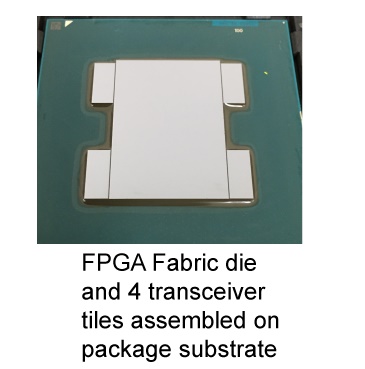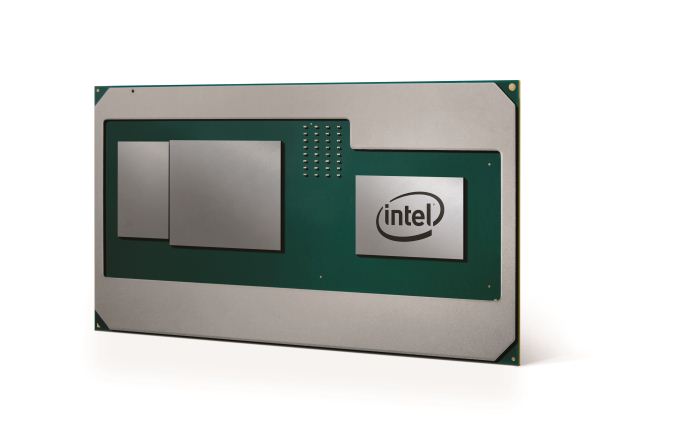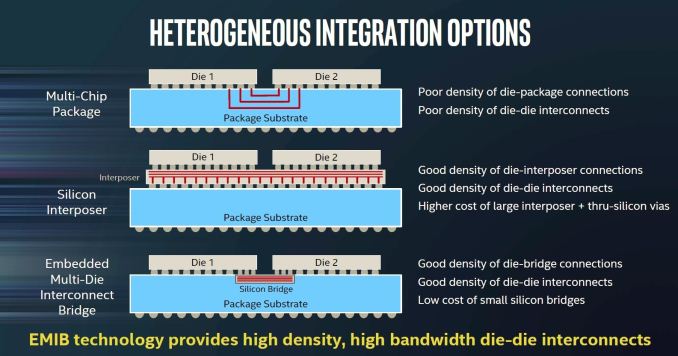Intel to Create new 8th Generation CPUs with AMD Radeon Graphics with HBM2 using EMIB
by Ian Cutress on November 6, 2017 9:43 AM EST
Today we have an announcement out of left field. Intel has formally revealed it has been working on a new series of processors that combine its high-performance x86 cores with AMD Radeon Graphics into the same processor package using Intel’s own EMIB multi-die technology. If that wasn’t enough, Intel also announced that it is bundling the design with the latest high-bandwidth memory, HBM2.
Intel announced its EMIB technology over the last twelve months, with the core theme being the ability to put multiple and different silicon dies onto the same package at a much higher bandwidth than a standard multi-chip package but at a much lower cost than using a silicon interposer. At Intel’s Manufacturing Day earlier this year, they even produced a slide (above) showcasing what might be possible: a processor package with the x86 cores made on one technology, the graphics made in another, perhaps different IO and memory or wireless technologies too. With EMIB, processor design can become a large game of Lego.
EMIB came to market with the latest Intel Altera FPGAs. By embedding the EMIB required silicon design into the main FPGA and each of the chipsets, the goal was to add multiple memory blocks as well as data transfer blocks in a mix and match scenario, allowing large customers to have the design tailored to what they require. The benefits of EMIB were clear, without the drawbacks of standard MCP design or the cost of interposers: it would also allow a design to go beyond the monolithic reticle limit of standard lithography processes. It was always expected that EMIB would have to find its way into the general processor market, as we start to see high-end server offerings approaching 900 mm2 over multiple silicon dies in a single package.
Since the EMIB announcements, Intel’s Manufacturing Day, and Hot Chips, word has been circulating about how Intel is going to approach this from a consumer standpoint. As part of the requirements of Intel’s own integrated graphics solutions, a 2011 cross-licensing deal with NVIDIA was in place – this deal was set to expire from April 1st 2017, and no mention of extending that deal was ever made public. A couple of rumors floated around that Intel were set to make a deal with AMD instead, as despite their x86 rivalry they were a preferred partner in these matters. Numerous outlets with connections in both AMD and Intel had difficulty prizing any information out. Historically Intel refuses to comment on such matters in advance. Other potential leaks include published benchmarks over at SiSoft, although nothing has been made concrete until today.
Intel’s official statements on the announcement offer a few details worth diving into.
The new product, which will be part of our 8th Gen Intel Core family, brings together our high-performing Intel Core H-series processor, second generation High Bandwidth Memory (HBM2) and a custom-to-Intel third-party discrete graphics chip from AMD’s Radeon Technologies Group* – all in a single processor package.
Intel interestingly uses a singular word for ‘product’, although this does not indicate if it is a family or literally a single SKU in the works. On Intel’s Core-H series processors, these are currently Kaby Lake based running at 45W, with Intel’s integrated GT2 graphics. It would be interesting to see if the graphics of the Core-H are then stripped out as a new silicon design, or if they are re-spinning the full Core-H silicon as a result and just displaying the integrated cores, or are able to run both graphics segments independently (it is likely a new spin of silicon, if I were a betting man). The use of HBM2 is not unsuprirising – Intel has successfully integrated HBM2 into its Altera EMIB-based products so we would suspect that this is not going to be overly difficult.
The next bit is the interesting one: ‘custom-to-Intel … discrete graphics chip’ from AMD RTG. This means that none of AMD’s current product stack has silicon dedicated to EMIB, but AMD is going to leverage its semi-custom design to provide graphics chiplets for Intel to add to its silicon.
‘In close collaboration, we designed a new semi-custom graphics chip, which means this is also a great example of how we can compete and work together, ultimately delivering innovation that is good for consumers… Similarly, the power sharing framework is a new connection tailor-made by Intel among the processor, discrete graphics chip and dedicated graphics memory. We’ve added unique software drivers and interfaces to this semi-custom discrete GPU that coordinate information among all three elements of the platform.’
One of the questions about running multiple chips in a single package is how to manage all the bandwidth and power. AMD has recently solved that issue in its server processors and inside its APUs by using their Infinity Fabric, which if I were to guess would not be under the purview of this collaboration. It states that with collaboration that the chip shares a power framework, which will be an interesting deep dive when we get information as to whether Intel offering separate power rails for the CPU and GPU segments, using an integrated voltage regulator (like Broadwell did), or doing something similar to AMD by using a unified power rail sharing mechanism with digital LDOs as was announced with Ryzen Mobile only a couple of weeks ago.
‘Look for more to come in the first quarter of 2018, including systems from major OEMs based on this exciting new technology.’
It looks like Intel is ready to make some announcements over the next few months on this project, and CES is just around the corner in January.
Though taking a step back, we have to consider what this means and what market Intel is aiming for. AMD recently launched (with products coming soon) their Ryzen Mobile platform, designed with quad-core Zen and up to 10 CUs of Vega graphics. The announcements from Intel and AMD do not state what graphics core they are using (they could be one generation behind for competitive reasons?) however it does state that they are using Core-H series processors, which are typically in the 45W range. AMD currently hasn’t announced anything in that segment, and deciding to focus Ryzen Mobile at the thin and ultralight notebook categories first. If AMD does bring Ryzen Mobile up to more powerful devices, then this new product will be in direct competition.
Looking at the image provided by Intel on the new product arrangement actually adds a new question or two to the bucket list. Here we have an Intel chip on the right, the AMD custom graphics in the middle, and the HBM2 chip next to it. The Intel chip is a long way away from the AMD chip, which would suggest that these two are not connected via EMIB if the mockup was accurate. The close proximity of the big chip in the middle to what looks like a HBM2 stack does suggest that it is connected via EMIB, as given by how close the chips in the Altera products are:
EMIB is being used, but it does not look like it is being used for all the chips together. It’s worth noting that neither Intel nor AMD offered pre-briefings on this announcement, so there are a lot of unanswered questions hanging around as a result.
A final thought. Apple uses a lot of Intel's 45W processors for iMacs; offering AMD graphics (Apple's preferred pro-graphics partner) into the segment that previously Intel's Crystalwell/eDRAM based products exist might be the next step on that product cycle evolution.
Source: Intel
Source: AMD
More Commentary
After an hour or two to digest, we have some new thoughts.
Firstly, judging by the wording and Intel's launch video, it can basically be confirmed that EMIB is only being used between the GPU and the HBM2. The distance between the CPU and GPU is too far for EMIB, so is likely just PCIe through the package which is a mature implementation. This configuration might also help with power dissipation if the chips are further apart.
The agreement between AMD and Intel is that Intel is buying chips from AMD, and AMD is providing a driver support package like they do with consoles. There is no cross-licensing of IP going on: Intel likely provided AMD with the IP to make the EMIB chipset connections for the graphics but that IP is only valid in the designs that AMD is selling to Intel (it's a semi-custom foundry business, these agreements are part of the job).
With Intel buying chips from AMD, it stands to reason they could be buying more than one configuration, depending on how Intel wanted to arrange the product stack. Intel could pair a smaller 10 CU design with a dual core, and a bigger 20+ CU design with a quad-core mobile processor. A couple of benchmark sources seem to believe that there is at least two configurations in Polaris-like configurations, with up to 24 CUs in the high-end model. We will obviously wait before confirming this, as Polaris is not originally built for HBM2 memory. Normally with HBM2 it requires a GPU that is designed to be fed by HBM - data management is a key operation. However, if it works 'naturally', then it should be a case of attaching the HBM2 controller IP to the GPU and away you go.
In an ideal world, it would make sense for AMD to sell Intel their Polaris designs, and for their own products say at least one generation ahead. With AMD's financial success of late, they could be in a position to do this, or Intel might be offering top dollar for the latest design. Neither company have commented on the arrangement between the two companies yet other than their press releases.
In discussions with Peter Bright from Ars Technica, we have concluded that it is likely for the Intel GPU to still keep its own integrated graphics, and the system could act in a switching graphics arrangement. This would be easy if the CPU and GPU are connected via PCIe, as all the mechanisms are in place. With the Intel integrated GPU already there, video playback would be accelerated and kept on die then sent to the display controller - it would allow the GPU and the HBM2 to power down, saving energy. If the GPU and HBM2 were kept powered up, then we would see reductions in battery life for future devices.
It has been discussed if this is a play just for Apple, given that Apple was behind Intel implementing eDRAM on its Crystalwell processors, and the latest generation of Crystalwell parts seem to be in Apple iMacs almost exclusively. That being said, Intel has stated that they have multiple partners interested in the design, and we should expect more information with devices in Q1. With Intel saying 'devices', it stands to reason that there are various OEMs waiting to work with the hardware.
As for the types of devices that we will be seeing, this one is a little confusing. Intel quoted Core-H series CPUs, which are 35W/45W parts. This also gels with comments saying that these new parts and Ryzen Mobile would not be in direct competition. However, in the demo video provided, it is clear that the potential for this design to go into thin and light notebooks like 2-in-1s and ultra-portables is on Intel's mind. Does that mean Intel is targeting 15W? Well if Intel is buying multiple configurations of chips from AMD, then strapping a dual-core i5 to 10 CU graphics part is more than plausible. If AMD is selling Intel the older Polaris design, the AMD has that advantage at least.















252 Comments
View All Comments
PeachNCream - Tuesday, November 7, 2017 - link
I can only talk for basic office tasks, web browsers, video playback, and little bit of light gaming (a few native games and a couple things through WINE that I reall love), but my experience with Linux and Intel graphics hasn't been bad. They're not gaming GPUs and they perform worse than under Windows, but that's true of nividia and AMD also...graphics performance just isn't comparable from any company's graphics. So don't use your computer for games. Buy a PS4 or something.Notmyusualid - Tuesday, November 7, 2017 - link
@ CajunArsonI'm not greedy, I only want ONE of those billions...
haknukman - Tuesday, November 7, 2017 - link
profit has nothing to do shitty intel hd graphicZeratul56 - Monday, November 6, 2017 - link
Never thought I would see the day. I guess the earth is about to freeze over.On a serious note, this would be great for on the go gamers. I use my skylake tablet to game quite a bit on the airplane. If I could get a device to boost the graphics just a little bit that would be nice.
blppt - Monday, November 6, 2017 - link
+1 on this, I had to check the date to make sure this wasn't april.IGTrading - Monday, November 6, 2017 - link
Remember how many slammed Fudzilla.com, HardOCP.com and SemiAccurate.com for breaking this news back in February 2017 ?!We hope everybody will politely apologize and #readmore before speaking on matters they don't master.
February 2017 : http://www.fudzilla.com/news/processors/42806-inte...
May 2017 : http://www.fudzilla.com/news/graphics/43663-intel-...
They didn't get all the details right, but they got the bottom line.
This is Intel's official admission that INTEL CANNOT BUILD GPUs.
It's done and over. They've wasted over 10 billions on failed projects only to end up begging AMD to help them.
The "poetic" words are well chosen on our behalf : Intel is desperate to cut nVIDIA's sales and profits therefore all those tens of millions of laptops with nVIDIA graphics are going to suddenly dissappear.
Intel does this because it sees nVIDIA as a much bigger threat than AMD and they hope that by cutting their revenue down, they will put pressure on nVIDIA's R&D budgets.
For nVIDIA, this remains to be seen how it plays out.
For AMD this is a God-send:
1) AMD's Raven Ridge will power AMD-based laptops and bring revenue to the company (that was previously 0% in the Thin&Light market)
2) AMD will still be present on the low end notebook market
3) AMD ensures THEIR GPUs are in 80% of the laptops sold in the whole world, displacing nVIDIA with a serious revenue increase.
4) AMD's software optimization base suddenly improves if developers make the effort to take advantage of all the compute abilities brought by AMD's iGPU
There will also be a downside : Intel may decide to completely annihilate AMD in the low end market, because obviously the CPUs that not reside in notebooks between 400 USD and 700 USD will be moved lower on the scale, where AMD's Bristol Ridge can barely face them.
This is one of the most strange partnerships we've seen i the past 15 to 20 years and it goes to show that Intel is capable of anything in its attempt to annihilate the competition.
Moreover, considering Intel's past history, we hope AMD's net gain from such a strategy is significant, because Intel is always dangerous and literally up to no good : https://www.youtube.com/watch?v=osSMJRyxG0k
Gondalf - Monday, November 6, 2017 - link
" INTEL CANNOT BUILD GPUs " bold statement dude, come on :). The real issue are the patents, i know this, you know this. "INTEL CANNOT BUILD PROFITABLE GPUs" sounds much better.A good GPU is all but definitively not rocket science, for example a good cpu is much complex to realize, by a wide wide margin.
IGTrading - Monday, November 6, 2017 - link
Intel lost more than 10 billion USD on failed GPU projects and ALWAYS FAILED to beat even the worst performing GPU from both, AMD and nVIDIA.It has nothing to do with profitability.
When you have all the money in the world and spend years and years on the project and the result is such a failure that it fails to beat the low end of the competition, that means you can't build GPUs, no matter if they're profitable or not.
IMHO
Santoval - Tuesday, November 7, 2017 - link
You appear to be unaware that Intel's iGPUs employed some Nvidia patents between 2011 and 2017. That was the result of a cross-licensing agreement between Nvidia and Intel which lapsed in early 2017 (hell, it is even mentioned in this article). So Intel was restricted patent-wise since at least 2011, and they decided to buy GPUs from AMD instead of beating the same patent horse from Nvidia.You need to realize that Nvidia did not provide Intel with their "crown jewel" GPU patents, but rather patents for basic GPU functionality (just as Intel did not grant them a x86 license from CPU side). So, since almost all GPU related patents had already been picked by Nvidia, AMD or ARM, and Intel could only work with a very limited set of Nvidia patents, Intel's iGPUs would *always* be handicapped. Intel, despite their very significant resources, could not reinvent the (GPU) wheel.
pSupaNova - Tuesday, November 7, 2017 - link
"So, since almost all GPU related patents had already been picked by Nvidia, AMD or ARM, and Intel could only work with a very limited set of Nvidia patents, Intel's iGPUs would *always* be handicapped. Intel, despite their very significant resources, could not reinvent the (GPU) wheel."Intel has been in this game for years they could have built up their own IP, Apple has managed to do it.